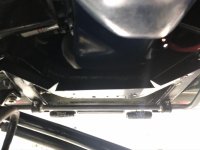Ran a few more models. As far as inputs for the program, it's just velocity of the fluid and boundary conditions. It sees the object as stationary, though I set the wheels as a spinning boundary layer. Once it's done calculating, you can select faces of the object to see how it thinks the fluid would interact with them (there's other options too, but that seems the most useful for this stuff).
Like before, this is simulating the truck moving @ 60 mph. I made a couple tweaks to make the gaps at the spare tire and core support more accurate.
No real surprises with any of these. First is standard passenger side exhaust.
Next two are rear exhaust, the first is level with the rear bumper, the second is set 5" back.
Next section is more interesting I think. I modeled the radiator as a rectangle with a bunch of square tubes it in. Was gonna do fins, but my computer didn't enjoy that. I didn't include a fan cuz I have no idea how to do that. Here the arrows are only showing flow that contacts the face of the radiator.
Section cut eliminating the front grille:
Section cut eliminating the grille, the driver side of the truck, and everything above the hood:
This is really making me wanna fabricate some air dams.




















